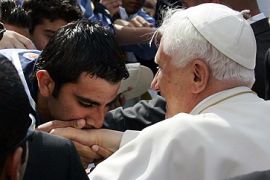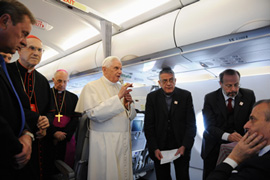Reporter’s diary: Barbara Serra
Pope Benedict kicks off his first visit to the Middle East.

 |
| Pope Benedict XVI is on his first trip to the Middle East [Gallo/Getty] |
Al Jazeera’s Barbara Serra is travelling with the pope on his current trip to the Middle East. She will be keeping a daily reporter’s diary as part of our special coverage of the first papal tour of the region.
|
Aboard the Papal plane, Friday, May 8, 2009 |
 |
| A press conference for journalists took place on the papal plane to Jordan [AFP] |
A news conference at 11,000 metres was always going to be slightly different.
Add to that an interviewee who is the spiritual leader of more than 1.1 billion Catholics around the world and you have an initial press conference of Benedict XVI’s first trip to the Middle East.
The conference took place on the papal plane as the entourage headed from Rome to Jordan.
Banish any mental images you may have of Air Force One. Prayer Force One, as some journalists have artfully dubbed it, is a humble Alitalia Airbus A320, which is normally part of the general fleet until it occasionally receives a higher calling.
The pope and his entourage of at least two dozen aides occupy the front of the plane, while at least 70 journalists, cameramen and photographers are unsurprisingly relegated to the back.
Veterans of such trips say that the late Pope John Paul II used to come and chat with the journalists, answering questions and making a joke or two.
Benedict, his successor, is much more reserved. We only saw Benedict XVI once, during the press conference, if one can call it that.
Questions prepared by journalists were submitted in writing the previous week. Four were chosen and put to the pope by his own spokesman – hardly a grilling.
But considering that popes do not usually give interviews, it will probably be the only time during the trip that he will take questions from journalists.
Playing safe
It is obvious that Benedict’s entourage were playing it safe and who can blame them.
The now-infamous comments the pope made during a speech at Regensburg University in 2006 linking the Prophet Muhammad to violence offended many Muslims.
His recent revoking of the excommunication of a bishop who turned out to be a Holocaust denier outraged Jews in Israel and beyond. But it’s the peace process, or lack there of, that more than anything could prove to be a diplomatic minefield.
Benedict XVI has stressed that he’s on a pilgrimage and not a political trip, but this is the Middle East and his comments will invariably acquire a political dimension, especially so soon after the war in Gaza.
On the plane he was asked what role he could play in any lasting peace between Israelis and the Palestinians.
He said that the Church was not a political power but a spiritual force, one that was a reality that can contribute to progress.
Certainly a noble sentiment, but one which lacks the detail anyone on the front line of the conflict would want to hear.
It’s no coincidence that the pope kicked off his trip in Jordan, which is seen as a success story of religious tolerance.
In Jordan, the Christian minority holds up to five per cent of the population, enjoying a high status in society along with peaceful relations with their Muslim neighbours.
The first place the pope chose to visit on Friday was a Catholic run educational centre for the disabled, which is open to people of all faiths – a symbol perhaps of the religious harmony he speaks of.
The pope will head to Israel and the occupied territories of Palestine on Monday, a region where religious harmony is in short supply – that is when the real challenges of his trip will begin.